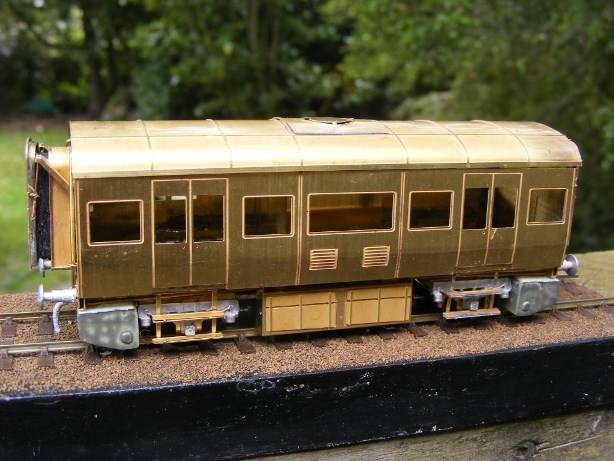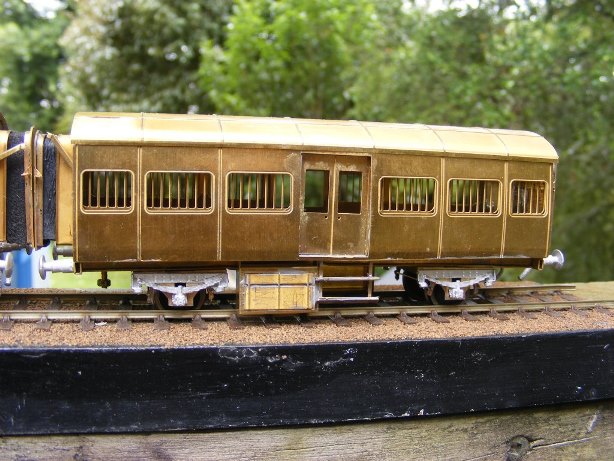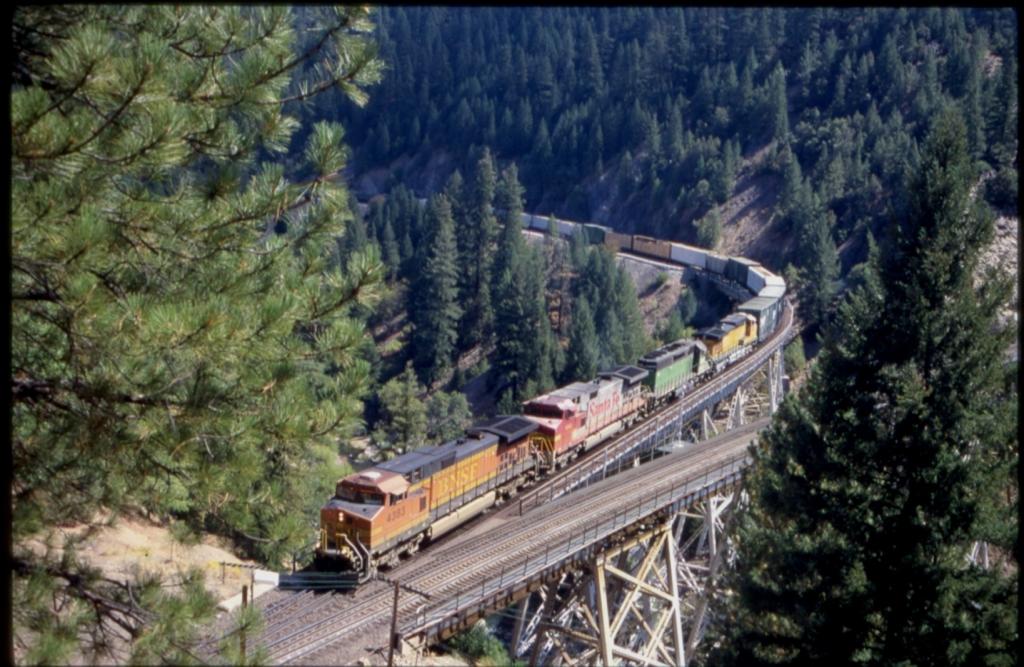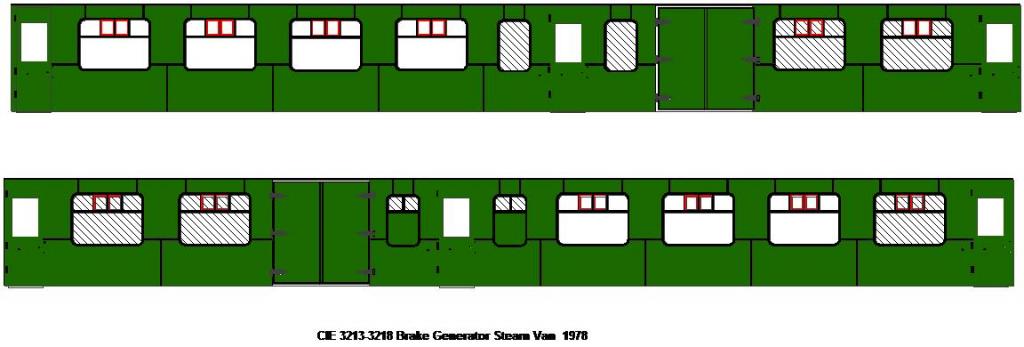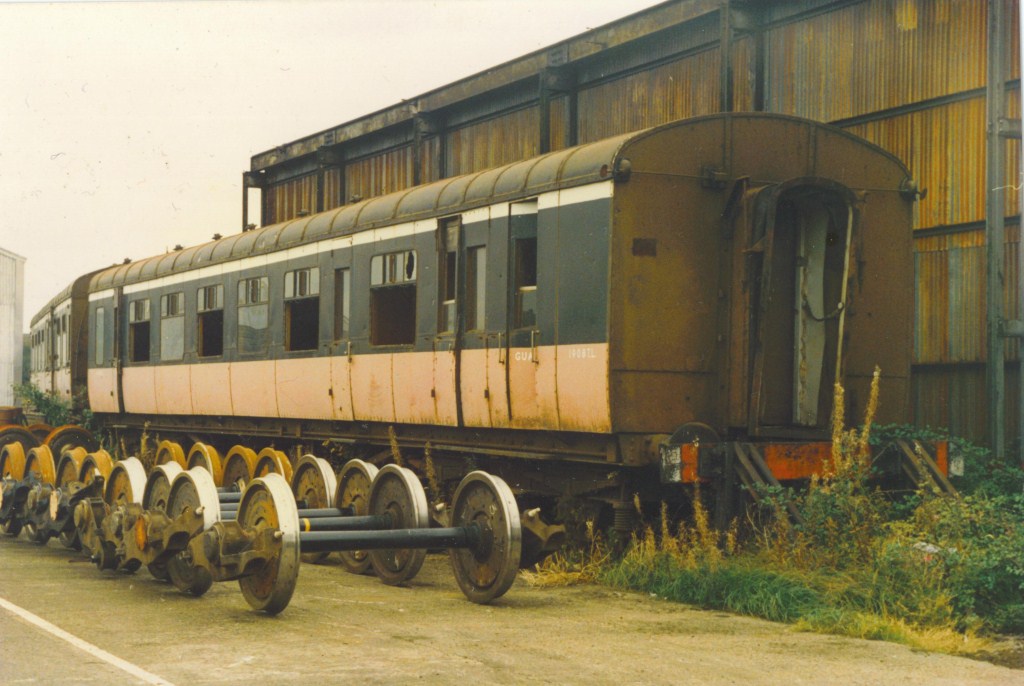-
Posts
4,232 -
Joined
-
Last visited
-
Days Won
98
Content Type
Profiles
Forums
Resource Library
Events
Gallery
Blogs
Store
Community Map
Everything posted by Mayner
-
I think its been a combination of external and internal factors including changes in transport policy including the de-regulation of the road transport industry, Government pressure on IE to focus on passenger services rather than run a mixed traffic railway. The loss of major customers such as IFI, Bell, Asahi and eventually Geencore, Guinness and Irish Cement. Some traffic was lost to industry closure, road competition and changes in shipping patterns. The failure of Bell Lines effectively ended North Esk, The Holyhead Yard and Grovesnor Road freight yards role as inland ports for Waterford. Traffic that was once shipped by rail through Waterford Port goes out directly through a local port. Road haulage was de-regulated in the early 1990s effectively breaking up CIEs and the Licensed Hauliers monopoly on road haulage. The long term future of the railways are still under question with investment dependent on EU Grants into the early 2000, Government policy required CIE to sell surplus land to fund investment in passenger services. One Transport Minister publicly stated that the Government was not in the business of subsidising the railways to transport freight for private business. (Possibly the risk of the road transport industry bringing a case to the EU over unfair competition by a Semi State Company). An experienced management team that had done a reasonable job on running a railway team were replaced by a team who had little or no experience in running a mixed traffic railway with low traffic density. In a way the situation is similar to the UK in the run up to privatisation when freight traffic was loaded up with costs in order to drive away business. There appears to be an element of double dipping by IE with costs, the current General Manager has admitted that full infrastructure costs are charged for running freights on passenger lines although these costs are already charged out to the passenger services. The tide may be turning in a similar manner to the UK the run down of Road Liner as a competitor may lead transport companies like to use rail for line haul work and develop their own rail serviced depots and used leased rather than railway company wagons. IE have indicated that short train lengths are an issue and are looking at the feasibility of running longer trains at night to avoid issues with short passing loops on single lines
-

The Official Irish 'Might Have Beens' Thread
Mayner replied to minister_for_hardship's topic in General Chat
There is a couple of photos and a short piece on the diesel railcar in E M Patterson's The Ballymena Lines. The builder is said to be the Belfast firm of Gardner-Edwards, a very neat looking single unidirectional unit possibly with an underfloor engine powering the trailing bogie with coupling rod drive. -
Excellent piece of modelling.
-
The depot hoist is more suited to a large loco depot than a railway goods yard. Waterford had a hand operated gantry outside the shed, Grand Canal Sheet had a sheerlegs Most goods yards had a simple hand operated crane the Wills Kit is based on the crane at Castlerea on the Mayo Line http://www.buffersmodelrailways.com/products/kits-192/station-195/wills-ss51-yard-crane-plastic-kit-oo-scale/item Most Irish goods yards were relatively small usually with a siding serving a goods shed and loading bank often with a hand operated crane for sundries and less than full wagon load traffic, larger yards usually had a separate siding with a loading bank for wagon load and cattle traffic. Coles Cranes appear to have been introduced in larger depots the 1960s to mechanise the loading/uloading of wagons, gantries started to appear with widespread containerisation from the mid 1960s onwards http://www.corgi.co.uk/coles-argus-6-ton-crane-yellow.html The goods shed operated in a similar manner to a modern couriers depot wagons as a warehouse and distribution centre goods could be delivered by the railway road delivery service or picked up by a customer. With wagon load the customer was responsible for loading or unloading the wagon, a farmer or merchant might by a wagon load of cement or fertiliser and sometimes use the wagon as storage unloading the wagon at his or her leisure. Beet was originally loaded by hand, in the late 50s ramps were built on many cattle banks to allow loading by tipper lorries sometimes carters sometimes CIE owned trucks.
-
Could end up in a situation with drastically reduced rail services even before the current stock of railcars wear out. A recent IRS Journal Department of Transport report indicates that the Government is planning to take a hard look at rail transport funding, with completed roading projects providing a far favourable rate of return in cost benefit analysis compared with rail. heavy rail accounting for a disproportionate level of state transport network costs · What is the future envisaged role of rail transport in Ireland? · What extent of the rail network is it appropriate to retain? The Department of Transport view appears to be that heavy rail is providing poor value for money compared with roading in terms of state transport network costs. 20% of state costs to support 1% of freight tonne/km and less than 5% of passenger/km.
-

Belmond Hibernian - Luxury Touring Train
Mayner replied to Broithe's topic in What's happening on the network?
My father once lived in the mountains above Brittas and had memories of the D&B in its final years even then some of the areas along its route had a bit of a reputation of being what we now call 'anti-social". Rural places can be downright dangerous if you don't know the lie of the land. A group of us on a railfan trip to the Cass Scenic Railroad in West Virginia were advised to steer clear of the local taverns unless you were packing a gun. American street gang culture can be prevalent even in the remotest of villages, a person can get into serious trouble by turning up in the wrong colour car or wearing the wrong colour tee shirt Locals can be suspicious of strangers wandering into their territory particularly if they are distilling moonshine or some of the newer cash crops. -

Belmond Hibernian - Luxury Touring Train
Mayner replied to Broithe's topic in What's happening on the network?
In the States they call it the "wrong side of the tracks" I know a few towns where there is no right side some surprisingly small places. -
Trying to gauge if there I sufficient interest to release a second run of Tin Vans. The Heating and Luggage (tin van) and Luggage (hooded vans) are out of stock a small number of TPO/Heuston Vans are in stock at $106 + $20 shipping ($NZ) approx. ₤55 Stg+₤10 shipping. 4w Post Office Van The original Tin Van kit was based on the early version of the van as introduced in 1955, if there is sufficient interest it may be feasible to supply the kit with later variations of the van including recessed doors or blanked out windows. Tin Vans Luggage Vans
-
There seems to be enough interest to go ahead with sides for the 3 types of coach. The BGSV has fired up a lot of interest, has anyone a photo or sketch of the generator/boiler roof hatches and exhaust detail? What is the general feeling around a complete coach kit on a similar principal to my Tin Vans or the SSM Bredins Vs plastic surgery and overlays to the Dapol body shells? The coaches could be designed to run on Bachmann or Hornby rtr LMS bogies similar to the GSR type with brass fold up bogies as an option for 21mm gauge.
-
Apart from taking to exhibitions building a layout in sections so that it can be dismantled and re-erected on another site can be important if you have to move home/country/continent. I have moved layouts from the UK to Ireland to New Zealand and since moved home twice without having to scrap everything and start over again. Foamboard tends to be widely used in the United States for baseboards for permanent layouts. Patricks layout is a good example of using this type of construction for a walk around layout http://irishrailwaymodeller.com/showthread.php/1102-Patricks-Layout Probably one of the most concise articles on the pros & cons of the various types of baseboard. http://www.009.cd2.com/members/how_to/baseboards.htm
-
Exactly termed guard rather than check rails standard practice in most countries to reduce the risk of vehicles falling off bridges and viaducts in case of de-railment and passengers ending up in the Irish Sea in the case of Bray Head. Guard rails on both Keddie Trestles
-
We sound like junkies talking about our stashes of Floquil maybe its the xylene/toluene Dio-Sol thinner :Happy1 Most of our local hobby shops stocked Floquil so I built up a reasonable stock, but its starting to run down a bottle of paint does not go far on a G Scale loco Well spotted for identifying the loco as a Baby Mudhen the original Bachmann Spectrum 2-8-0 looked totally out of proportion with their Big Haulier and LGB stock & the C21 was the simplest conversion and a lot easier on the finances than trading up to Accucraft http://www.accucraft.com/modelc/AL88-120-C.htm Herself would have serious questions to ask if I spent $3000 on one loco
-
The overlays are etched brass and designed to fit the Dapol Stanier 60' side corridor coaches more details are on the JM Design Facebook page https://www.facebook.com/jmdesignmodelrailways Kieran did a thread on his Workbench on building a rake of "Bredins" with these sides http://irishrailwaymodeller.com/showthread.php/78-Kirley-s-Projects/page64. If there is sufficient interest I will look at doing a set of etched parts to complete a scale length model of these coaches on a similar principal to the tin van kits. A common underframe and ends fret could be shared between several types of coach, with separate roof fret or moulding SSM or Comet may be able to supply suitable castings which would reduce tooling costs and speed up introduction. The overlays are $32Nz+$10 postage approx ₤16 postage + $5
-
Definitely not Irish but possibly what might have run if the main lines were built to the narrow gauge or someone got hold of some bootleg GSR paint The loco is fairly heavy rebuild of a Bachmann 2-8-0 to resemble a Rio Grande loco. The loco is finished with Floquil dirty black with the smokebox in graphite and the whole loco finished in a semi gloss clear. I originally finished the loco in satin black and was not happy with the 'colour" I will try and add something Irish and in 4mm soon
-
I am trying to establish if there is sufficient interest to add further coach sides to the Buffet & Corridor Second released last year. The illustrations are in green because I was too lazy to draw them in black & tan Originally built 1953 classified as 3rds built to run as railcar trailers 1356-1371 were the first of CIEs family of 64 seat standard open coaches. These coaches were also very close in outline to 1497-1503 some of the last traditional coaches built at Inchacore in the early 1960s. Originally classified as 3rds and introduced in 1953 some of these coaches were converted to driving trailers for use with the AEC railcars on the Westland Row-Galway & Westport "Cu na Mara" express service. One of these coaches was later fitted with storage heaters for use on the Ballina Branch These coaches seem to have originally been introduced with guards look outs, some of which were later plated over, separate frets would be required for coaches with or without lookouts. One of the coaches on the Loughrea Branch not sure of the identity of the photographer Almost modern image introduced in 1978 Brake Steam Generator Van converted from 1953 Side Corridor Coach This fret will be a tad more expensive than the ordinary coaches and a bit more involved to build as the van doors will have be engraved on a separate section of the fret to the sides. I am looking at expressions of interest for a minimum run of 6 of any one type.
-
Probably been in the hobby longer than I remember, being more of a builder and operator than a collector my collections tend to depreciate rather than appreciate in value. More mission creep than most military the besides the Irish stuff, expensive excursions into British OO, OO9 & EM gauge, American HO, N & On30, and now G Gauge. Missus is fairly laid back and supportive of it, at least she knows I am unlikely to be with a Flousie if I am in the garden or workshop
-
Interesting how positive the narrator Paul Shannon was about the Irish railfreight scene compared to British Rail. At the time BR was shutting down any freight traffic that did not achieve a certain rate of return, ten years later the situation was more or less reversed.
-

Midland Great Western Railway carriage livery and Broadstone photographs.
Mayner replied to Ian's topic in General Chat
One of the beauties of a layout based on the Achill line is that you can get by with very little in the way of locos and stock. In 4mm the E & the MGWR & GSWR Convertible Wagons are available from SSM, the D17 is on the SSM wish list. Jeremy Suter once produced a very nice MGWR open box wagon. Kits for the horse box and meat van are just about ready for release and if you can wait long enough the D Class and some of the MGWR 6 wheel coaches are on my wish list. If you have the space O Gauge would be a better option than 4mm for building locos and stock. Dave Holman's SLNCR layout shows what can be achieved in a small space in 7mm using a combination of kits and scratchbuilding. If you are planning on 3d printing the larger scales are more forgiving of the coarse surface texture you get with the 3d printing process. -
The hopper looks well, the buildings are distinctly Irish with the bedroom over the archway.
-
Irish Steam A twenty year survey1920-1939 O S Nock David & Charles 1982 goes into a considerable level of detail on the 400 including the reasoning behind the differing nature of the re-builds http://www.amazon.com/Irish-Steam-O-S-Nock/dp/0715379615/ref=sr_1_1?ie=UTF8&qid=1429862494&sr=8-1&keywords=irish+steam+o+s+nock Nock was a professional railwayman who wrote widely about British locomotive practice Irish Steam contains logs of high speed runs behind the original and rebuilt 400 Class and includes a comparison between 800, The Scots & Lord Nelson Classes. Long out of print "A Decade of Steam in the 50s" published by the RPSI in the 1970s covers the 400s from a drivers perspective, if you send me a pm with your personal e-mail I will scan the section on the 400&800 Class.
-

Belmond Hibernian - Luxury Touring Train
Mayner replied to Broithe's topic in What's happening on the network?
An observation car. Wonder if its real or fevered imagination -
I hope the argument about common Vs separate return wiring is not confusing or putting our less experienced members off. In my experience once the controllers are fed through separate transformers or transformer windings common return wiring using single pole switches is perfectly adequate for most layouts, the system works fine with resistance, variable transformer or electronic controllers including modern Gaugemaster Common return wiring has been the standard in magazine the majority of magazine articles and books on layout wiring publish in the UK and United States during the last 50-60 years an it work. The majority of section switches supplied by manufactures like Peco, Hornby are single pole intended for common return wiring. I have built worked on several layouts large and small which worked fine with common return. The positive and negative flowing from separate transformers through a "common return" does not create a short circuit or any noticeable interference between controllers. I use a 40+ year old H&M Safety Minor unit with variable transformer speed control, a 20 year old electronic hand held controller built as part of a MRSI club project and a new Gaugemaster electronic hand held unit. I usually power one of the hand held unit off the 15V ac auxilary supply on the Safety Minor, the second hand held off a separate 15V ac power supply. Common return may be unsuitable for DC layouts where signalling is used to control train movements and is not recommended for large DCC layouts that are divided into booster or circuit breaker protected sections to prevent the entire layout shutting down if a loco derails or there is a short in one section.
-

What is the smallest usable 00 Gauge layout
Mayner replied to Chevron's question in Questions & Answers
John Allen's Timesaver idea bit more interesting than an Inglenook has stood the test of time http://www.wymann.info/ShuntingPuzzles/Timesaver/timesaver-rules.html could be fitted into a fairly space in OO -
I am not sure if its simply a case of NIH there appear to have been objections/restriction to sanding in the UK on account of damage to switch and crossing work and trains disappearing off track circuits. UK freight train tonnages are far heavier than Ireland Class 59 & 66 diesels use traction control systems rather than sanding to control heavy trains. The 071s have a reputation of being slippy but capable of putting up high milage between repairs on relatively heavy trains. Re-gearing to reduce top speed and a traction control system would allow the 071s to haul increased tonnage and longer trains. Sandite appears to be the preferred current day option for dealing with poor rail conditions in both the UK & Ireland Sanding the Highland Main line with a converted golf buggy 09:11
-
The gypsum hoppers seem to have been a joint venture between CIE & the GNR for Kingscourt gypsum traffic in the early 1950s. I was surprised to receive a faded GA drawing for the CIE version of these wagons rather than the more modern hopper when I wrote to the CMEs Office asking for a drawing of a gypsum hopper. Each company had a small fleet about 5-6 each and may have been used between Kingscourt station and the Gypsum factory siding rather than to Boyne Road. Standard CIE wooden and corrugated opens seem to have been the main types in use for traffic to Platin & Limerick & the Gypsum factory siding was out of use during an IRRS trip over the line in the mid 70s. Gypsum traffic later went over to block train operation using a more modern design of hopper wagon dating from the 1970s
.png.c363cdf5c3fb7955cd92a55eb6dbbae0.png)


